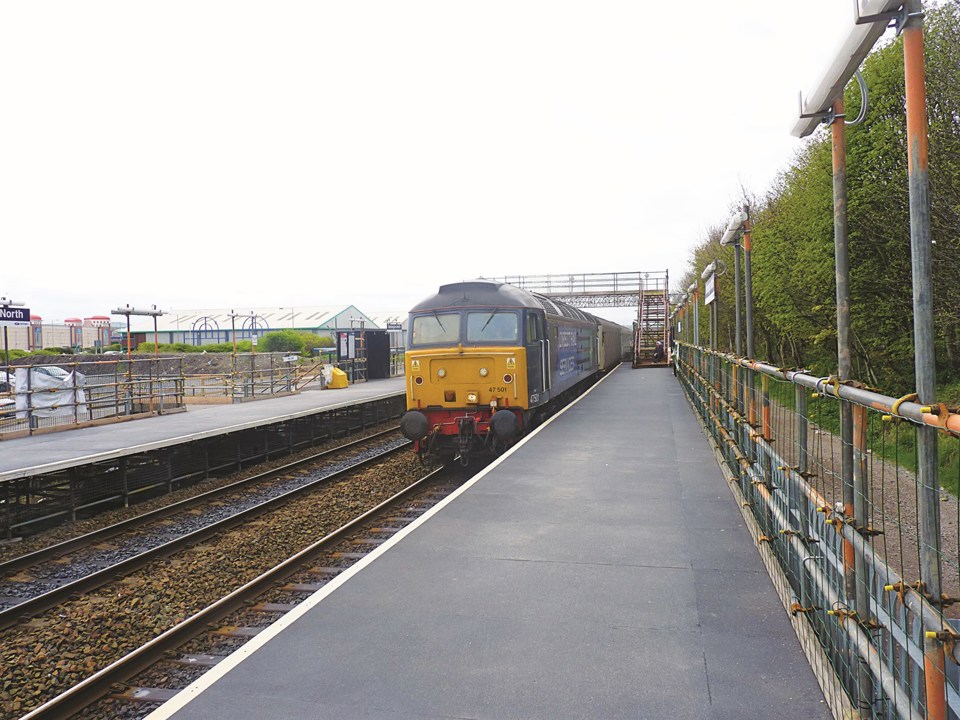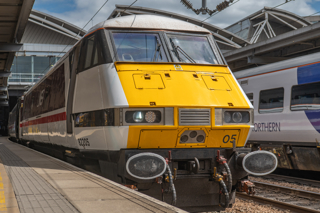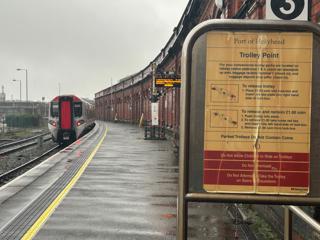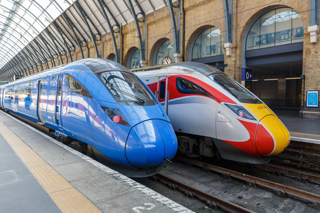It’s not hard to believe that the weather can play havoc with the Cumbrian Coast line.
Travelling towards Workington it was sunny above, but out to sea southern Scotland was shrouded in mist and rain. At Maryport the wind whipped along the single platform, with the small shelter providing little protection against the icy April winds.
The land is low and the railway kisses the sand dunes and the beach. It is also relatively flat - in the distance are the Lake District fells, but the dwellings of Maryport, Flimby and Workington are low-lying.
When storms lashed the coast and the Lake District on November 19 and 20 they had the sort of effect on the local infrastructure more familiar on television news broadcasts from overseas.
Bridges were smashed and communities torn apart after more than 300 millimetres of rain fell in the area in just one day. Some areas were eight feet deep, as water surged off the fells and into the River Derwent. The torrent of water rushed downstream and through Workington, taking a number of bridges with it.
The prominent one was that which carried the A597 into the town. This bridge connected both sides of the town, but when it was destoryed (RAIL 633), the community was split into two. Simple tasks such as shopping, going to school and visiting friends became incredibly difficult - it involved a 50-mile car journey to complete what was previously a five-minute trip.
Arriving in the town by train from the north presents two contrasting views. To the right the Derwent winds towards the sea, with pleasure craft bobbing in the waves. In the distance, the docks can be seen. To the left you look inland and just around the first bend is the road bridge that opened on April 20, the bridge funded by the Department for Transport to replace the original A597 crossing. But just in front of that are two very large protruding lumps of brick in the Derwent. These are the remains of the A597 crossing - a reminder of what Mother Nature is capable of.
But one structure stood strong… the railway bridge.
Northern Rail is the local train operating company (TOC) and runs passenger trains along the coast, but these were roughly hourly.
Four miles north of Workington is Flimby, which had been a request stop. Residents quickly flocked to this station and Northern’s trains, which had been busy at peak times but probably not to a level that could be described as overcrowded, suddenly found themselves ‘full and standing’. Northern Performance and Planning Director Rob Warnes says it was immediately obvious that “rail was an attractive solution to an acute problem”.
He explains: “Communities north of the river faced with a detour, and then sat in huge traffic jams, soon realised that rail was quick and easy.”
The trains, though, could not cope with the huge volumes. Where 20 or 30 people used to board, there were now up to 500 waiting for a two-car train. And the timetable along the coast is structured to serve different areas at different times.
“There is no commute from the north to Workington and the timetable is based around getting the workers to Sellafield. There is a regular commute up to Carlisle including a lot of college flows, but most traffic is to Sellafield,” says Warnes.
At the time there were no resources, or train crew, to increase the service. Northern, like so many TOCs, is struggling to provide capacity for existing flows, let alone surges such as this.
“Initially we saw huge volumes,” says Warnes. “We moved units from West Yorkshire and Greater Manchester, but that meant short-forming trains in those areas during that week.” (Leeds and Manchester are two of Northern’s busiest areas and already suffer chronic overcrowding, so there was a real problem).
On the coast, a timetable change was implemented. The 0744 Carlisle-Whitehaven was terminated at Workington and then ran to Maryport. Northern ran a bus down to Whitehaven to complete the original journey. This, says Warnes, was not sustainable.
More capacity was available to help with evening trains, but the outlook was not promising as the DfT said that a replacement road bridge would not be available for many months. Then came an offer of help…
Direct Rail Services is a freight company based in Cumbria. It has strong links with the Cumbrian Coast through running trains to Sellafield, where the company was initially set up. Staff live on the coast, and the floods would have affected them and their friends.
Managing Director Neil McNicholas told RAIL that as soon as he was aware of the devastation he was on the phone to Northern, seeing what could be done. Initially he planned to run trains to meet buses that would serve the affected stations.
This would allow capacity to be reduced on Northern’s trains. But then he had a better idea: what about running additional trains?
At the same time, Network Rail Route Director Jo Kaye quickly announced that a new station was to be built north of the river, about one mile from Workington station.
After rapid consultation with the local Allerdale Borough Council, work started on the site on November 24. Normal planning permission requirements were waived, and NR agreed a two-year lease deal with the council.
The station will never win awards for its architectural beauty, with its scaffolding and simplistic design, but for usefulness it could clean up. It cost £300,000, and was approved by NR Finance Director Patrick Butcher and Operations Director Robin Gisby, which allowed the company’s lengthy approvals panel and process to be cleared quickly. The location was determined using the company’s helicopter that was already in the area, giving aerial assessments of how badly the floods affected the railway.
On November 30, the station opened. By then, DRS had already run some shuttle trains between Maryport and Workington.
As the local operator, Northern would market the trains but only its safety case does not include locomotives and stock, which were to be used on the trains. However, Network Rail and the Office of Rail Regulation changed this quickly and Northern was able to run the trains. DRS runs them on its safety case - technically they are charter trains.
Says Warnes: “We ran the first train on November 27. We did not have locomotive-hauled trains on our access agreement, but the ORR helped. Some consultation periods that were needed normally took four weeks, but they said they would do that later. It was a showcase of the industry pulling together when it had to.”
But why DRS? “I had been on the train before when there was a community event in the North West, so I knew the stock and got to know DRS then.”
Two locomotives top and tail four coaches, running a roughly hourly service in each direction between Workington and Maryport. The coaches are three DRS Mk 3 Open Firsts (FO) and Mk 2D brake standard open (BSO) hired from West Coast Railway Company.
Both locomotives are left running to allow for a quick turnaround but because the train is not through wired it means that the rear locomotive needs to be manned at all times. Also, one locomotive had to be fitted with electric train heating (ETH) to power the systems on board the coaches. If this locomotive was switched off, then people could not get off the train because the central door locking (CDL), which is powered by the ETH, would not work.
Says Warnes: “It is a Northern service under our contract. We hire trains and the crews from DRS.” He says there wasn’t the opportunity to change the existing timetable to be more accommodating of the shuttle. Nor did the infrastructure on the Coast help, as it is full of single sections with long headways. So it ran in the gaps that were available.
Warnes says locomotive-hauled trains were the only option. “There was no more stock available and the DfT asked us to come up with an idea.” As a result, the DfT is funding Northern’s hire of the train and covers all the costs.
Previously, some trains on the route had been formed of single-car Class 153s - this quickly changed so that all trains were at least two-car formations.
Initially Northern used one of the five Class 142s made redundant by the closure of the Oldham Loop. This allowed a complicated cascade to be made which released a Class 156 for the coast. Another diesel multiple unit was required, ideally a Class 158 that could help in the Leeds area.
Instead, Northern got a Class 321 electric multiple unit! This meant another complicated cascade, resulting in another ‘156’ for the Coast. This allowed Class 153s to operate in pairs on services originally planned to use a ‘156’. Eventually a ‘158’ was hired from South West Trains, which allowed the ‘321’ to move elsewhere. The ‘158’ was due to return to SWT as RAIL went to press.
DRS also had to make changes to run the trains. The Mk 3s were moved from store at Crewe to Carlisle Kingmoor, where they were maintained and cleaned each night. This saw a cleaning company have its contract extended, and start cleaning rolling stock for the first time. Also, nuclear flask trains running along
the coast were re-timed to make way for
the shuttles.
But why did DRS run the passenger trains? McNicholas says: “Even though we are a freight company, we have had a passenger portfolio for quite a while, through the charters. We had the kit already, and thought it would be good to support Northern.”
McNicholas says the shuttles were DRS’ idea. “I told my directors to make ourselves known to Northern after the floods happened. I knew that shuttles were going to be the only way to move people.”
He says that moving the nuclear train from its timetabled path was not difficult - DRS has several paths along the coast, meaning it could be slotted into one of those. “As a local employer Sellafield was very supportive of the trains and what we were doing.”
He also recognised that the industry bent over backwards to help. “You needed flexibility and we got it. The DfT recognised what we were doing and helped.”
When the trains were running it was “all hands to the pump” says McNicholas.
“We have volunteers, and they trained as stewards for the trains. Some staff were also given short-term contracts, so in fact the floods enabled some people to get jobs! There was also a lad who wants to work on the railway who is heading to university next year. He is helping with the trains, which will look great on his CV.”
The trains are completely manned by DRS staff. The train is staffed with a driver, engineering support or additional driver (which allows the rear locomotive to still operate), guard and two stewards. The latter was reduced to one steward as DRS evaluated what exactly was needed. The trains are free to travel on, so the steward is there to help passengers with heavy luggage, pushchairs and shopping, as well as providing information.
The trains will finish on May 28. This is the third deadline given for the trains, after end-dates planned first for December and
then April.
Only recently the DfT gave £202,000 to allow the trains to continue running, but this time it looks like the end. When RAIL travelled on the shuttle, there was no more than ten passengers on the northbound service, and one on it when leaving Maryport. It is busier in peak-times, but with the funding tap switched off, the trains will stop. “It is a shame,” says a rueful McNicholas. “The infrastructure is there to support moving people to rail permanently.”
He says that there would be questions regarding where people would park. The current facilities are temporary, but could be made permanent, he believes. It is a model that could be replicated for possible workers trains to Sellafield (see panel).
Often the railway receives negative publicity, but the tale of how it rallied to help a stricken community is something to behold. What’s more, relationships have been built between two companies that could prove beneficial for passengers elsewhere in the country who at present are confronted by overcrowded trains. Workington has been a win-win situation for everyone.
- This feature was published in RAIL 644 on 19 May 2010
















Login to comment
Comments
No comments have been made yet.